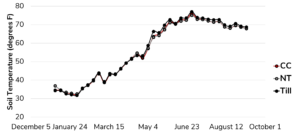Progress report for ONC21-087
Project Information
Future success of cover crop adoption will depend on demonstrating the economic value and agronomic feasibility to farmers. One of the biggest concerns farmers face when adopting cover crops is a fear of fields not drying out as quickly in the spring for planting. This has been exacerbated by recent weather patterns in Ohio resulting in exceptionally wet spring weather. In fact, in Ohio farmers are experiencing ten fewer days available for field work in April and May since 1995. The potential risk of delayed planting deters farmers from trying to add cover crops into their management practices.
To investigate this concern, we will place soil moisture and temperature sensors in fields with different management practices to measure differences in how the soil dries and warms in the spring. Soil tests to understand soil health benefits will also be conducted. In-field comparisons in random block design will be done where feasible and neighboring field comparisons will be used when not.
To maximize the impact of the research, an educational program will be developed to communicate the results of this study and, in addition, help farmers understand the benefits of cover crops and the options for adding them into their operation.
- Quantify the differences in spring soil moisture and temperature between fields under conventional tillage, no-till, and cover crop management using soil sensors.
- Develop educational resources about the implications of various field management techniques for farmers including YouTube video series, factsheets, and Extension curriculum.
Cooperators
- (Educator and Researcher)
- (Educator and Researcher)
Research
The objective was to quantify the differences in spring soil moisture and temperature between fields under conventional tillage, no-till, and cover crop management using soil sensors. In 2022, TEROS 11 sensors were installed in fields in the fall after field work was completed. 2 sensors were paired with 1 ZL6 data logger to measure soil moisture and temperature. For each data logger, one sensor was placed 3 inches below the soil surface and one sensor was place 6 inches below the soil surface. Treatments measured were: 1.) no-till with cover crops, 2.) no-till without a cover crop, 3.) tillage. Within the no-till with a cover crop, the goal was to have 2 treatments terminated prior to planting and 2 terminated after. Sensors were placed in neighboring fields. There were 3 paired sites with each treatment: 1 in Champaign County, 1 in Fayette County and 1 in Madison County. Sensors were placed in the same soil types in different fields with 2 sensors per treatment.
During the 2022 growing season, unfortunately at 2 sites all cover crops were terminated prior to planting leaving only 1 site with a pre plant and post plant termination comparison.
Sensors were removed at plant and then re-installed during the growing season to continue to monitor soil moisture and temperature.
Sensors were reinstalled for the 2023 growing season in early January, removed briefly on most sites for planting. and taken out for the final time prior to harvest at the end of the season. During the fall of 2023, data was analyzed and we developed our final presentation.
When comparing NT-CC to tilled and NT, no difference was seen in temperature through planting. After planting, tilled ground ran 2-4 degrees F higher from mid-April to June until the crop canopied. The tilled ground was about 1 deg F higher than NT-CC and NT through the rest of the season. Soil moisture at 3 inches varied between the 3 treatments with NT peaking as the wettest in March and NT-CC surpassing it in May. Tilled and NT-CC ran very closely together from Jan-Mar and then in April NT-CC started to have a higher moisture content. On average, during the summer months, NT-CC and NT retained more moisture than tilled but there were some deviations, possibly due to weather differences across the sites. Our final presentation with all graphs can be viewed at: https://go.osu.edu/SARESoilTemp.
|
Treatment |
CC Terminated |
Planted |
Crop |
|
2023 |
|||
|
Madison Co: NT, NT-CC |
21-Apr |
20-Apr |
soy |
|
Madison Co: tilled |
n/a |
19-May |
soy |
|
Fayette Co: NT, NT-CC |
26-Apr |
20-Apr |
soy |
|
Fayette Co: tilled |
n/a |
14-Apr |
soy |
|
Champaign Co: NT |
n/a |
17-May |
soy |
|
Champaign Co: NT-CC |
19-Apr, 26-Apr |
25-Apr |
corn |
|
Champaign Co: tilled |
n/a |
10-May |
corn |
|
2022 |
|||
|
Madison Co: NT, NT-CC |
6-May |
29-Apr |
soy |
|
Madison Co: tilled |
n/a |
13-May |
corn |
|
Fayette Co: NT-CC |
25-Apr |
29-Apr |
corn |
|
Fayette Co: NT, tilled |
n/a |
1-May |
corn |
|
Champaign Co: NT |
n/a |
14-May |
corn |
|
Champaign Co: NT-CC |
2-May, 24-May |
25-May |
soy |
|
Champaign Co: tilled |
n/a |
1-May |
soy |
Educational & Outreach Activities
Participation Summary:
The 2022 results were published in the 2022 eFields On-Farm Research Report and the final results were published in the 2023 eFields Report distributed across the state of Ohio and available online at: go.osu.edu/eFields.
Material was presented at 2 field days and 3 conferences including one international conference in Ontario.
Posters have been accepted at 2 conferences this summer, American Society of Agricultural and Biological Engineers (California) and the National Association of County Agricultural Agents (Texas).
Informational was shared at the Farm Science Review in 2023 which attracts 100,000+ attendees each year.
Videos have been recorded and are in the editing process.


